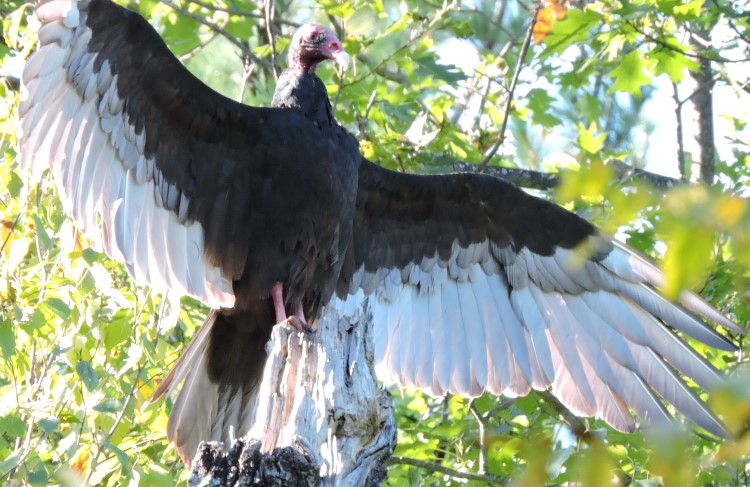
Before we bought the cottage, we had heard of turkey vultures. From time to time, we visited friends at their cottages and on a clear day we would look up, up, up, and we would ask what those birds were, circling high in the sky. Always the answer was the same, “they are turkey vultures”.
Ten years ago, having bought our own cottage on White Lake, we started to field the questions of nieces, nephews and others about what they saw in the sky, by replying, “turkey vultures”. But how did we know that? What was our evidence? At a wildlife lecture, we learned that if viewed head on, a soaring turkey vulture appears to be raising its wings in a V pattern. This was one hint. Another is the sense one has that these birds are looking for something, while soaring in circles and riding the thermals in the sky. Experts told us turkey vultures use their keen sense of smell to find the carcasses of dead animals. Turkey vultures are consummate scavengers, part of nature’s clean up squad.
Years went by and all we saw at the cottage were small groups of birds (turkey vultures) soaring high in the sky. We could not confirm our own identifications when our pictures turned out like this.

More time passed. We learned that turkey vultures occasionally roost in small groups, but they were still too far away for our camera to bring them into good view. This picture is a little like a ‘finding Waldo’ puzzle. How many turkey vultures can you see? [i]

A better camera allowed us to see the turkey vulture’s dark brown body, featherless red head and pale bill.

Last year, following an unfortunate deer / car altercation, the turkey vultures found the deer carcass in the ditch. While dozens of turkey vultures competed for the spoils, others took turns sunning in a nearby tree, providing us with the opportunity to capture both dorsal and ventral views. You can see the long “fingers” at their wingtips and long tails that extend past their feet while in flight. Turkey vultures appear black from a distance but up close you can see they are dark brown. While most of the body and forewings are dark, the undersides of the flight feathers are paler, giving a two-toned appearance.


We had similar (but different) difficulties capturing a good picture of our cottage neighbourhood wild turkeys which demonstrate nature’s ultimate success with camouflage. We often see wild turkeys grazing in the farm fields on the way to the cottage, and we know what they are, but from the car they are not much more than dark blobs in the distance. From time to time, one crosses our path and we break to avoid a collision, but grabbing the camera usually nets a photograph that seems to show road-side shrubbery. Can you see a wild turkey in this second ‘finding Waldo’ moment?

Only while walking was Bruce able to snap this picture of wild turkeys by the roadside, not in the shrubbery. Seconds after this picture was taken, they disappeared into the woods.

We are still hoping to capture a picture of a male turkey in full courting display.
Turkey vultures and wild turkeys do not have much in common aside from both being large, dark birds with featherless red heads. Turkey vultures are carrion-eaters and soar high in the sky looking for their food from above, while wild turkeys are granivores and ground-based.
For this article we used allaboutbirds.org, the Atlas of the Breeding Birds of Ontario, and our own observations and thoughts.
[i] We see nine.

